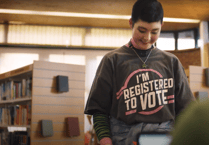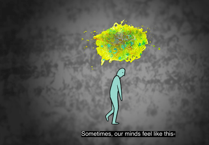The last portrait of poet Dylan Thomas has arrived at Carmarthenshire County Museum, where it joined thousands of other objects and artefacts which provide a glimpse into the past.
Painted at Thomas’s boathouse and writing shed in Laugharne by artist Gordon Stuart in September 1953 – two months before the poet’s death – the portrait was bought at auction by Carmarthenshire Council for £15,000.
The council-run museums service has around 42,000 “accessions” – a number assigned to each acquisition – which comprise some 70,000 individual objects.
Only a small proportion can be displayed at any one time.
Some objects are extremely old, like the 50,000-year old woolly rhinoceros and hyena bones found at a cave near Pendine.
Others, like Welsh tapestry blankets, are from a more recent age.
From fossils to minerals, medals, weapons, coins, pottery, books, paintings, apothecary jars, 18th Century shop signs, milk churns and cheese presses – the collection covers expected and unexpected bases.
“I don’t think there is a single person who knows everything about the collection,” said museums development manager Morrigan Mason, who started what was then a new post in 2016.
She said the objects were catalogued on a database and that a new system was being created to enable the public to access them.
“I think there’s a real appetite for people to understand what’s in their museums,” she said.
The county museum was founded by the Carmarthenshire Antiquarian Society in 1908.
Meanwhile, the exhibition space in the new-look Sands of Speed Museum, Pendine, will be much larger when it opens than its predecessor, the Museum of Speed.
Some objects, like early Christian standing stones, require specialist hoists to move them. One of these, the Voteporix stone, is a memorial to a 6th Century king of Dyfed. Its inscription translates as, ‘In Memorial of Voteporix: The Protector’.
Hay loaders and carts, meanwhile, take up a lot of space.
Mrs. Mason’s particular interest is art and portraiture, hence her excitement when a portrait acquired from the Golden Grove estate, near Llandeilo, was found to have been the work of 17th Century artist Mary Beale.
It had been attributed to “artist unknown”. The discovery featured on a BBC Four programme, Britain’s Lost Masterpieces, in 2017.
“We keep on discovering what we don’t know,” said Mrs. Mason. “We find more gems within our collection – I think that’s what’s so exciting about it.”
The process by which the museums service acquires new items depends on what the item is, its value and its source.
With an archaeologist, industrial archaeologist, conservator and art historian in its ranks, the service has expertise to draw from.
“We can take quite a well-rounded view of an object – it’s long-term cost, whether it can be displayed, and whether it has research or educational value,” said Mrs. Mason.
More expertise, as well as financial backing for new acquisitions, is provided by The Friends of Carmarthenshire Museum.
“We only have a small pot of money,” said Mrs. Mason. “More often than not we have to fund-raise.”
The majority of the £15,000 for the Thomas portrait came from the Art Fund charity and the V&A Purchase Grant Fund.
Mrs. Mason said the museums service had two independent valuations and a consultation assessment carried out before bidding for the portrait.
Finally seeing it in the flesh for the first time, on Friday May 14, was a thrill.
“It was really moving,” said Mrs. Mason. “The significance was the last portrait.
“You can see he is unwell. His head is down, his cheeks are swollen. The palette is very sludgy, dark and evocative.”
The painting, which has only been seen publicly twice since it was painted, will be displayed at the county museum’s new gallery later this year.
Museums also have to dispose of objects, and Mrs. Mason said this was more complicated than you might think.
“You have to build up a very strong case,” she said. “You have to check there is no ownership (issue), and no significant loss of knowledge. Disposals have to be transparent and ethical, and most certainly not for profit.”
A collections development policy sets out other parameters, such as defining the geographical boundary items should come from.
In among the rarer and more eye-catching artefacts and artwork, including a Roman collection, are more prosaic objects.
“It’s the whole detritus of human life from the last 200 years,” said Mrs. Mason.
“The every day, ordinary things, people find interesting. They remind them of their childhood, or how their grandparents lived.”
Some of these items have increased significantly in value.
Welsh tapestry blankets, said Mrs. Mason, typically sold for just under £100 not so long ago.
Nowadays, they can reach as much as £2,000 on the international market.
The value of Llanelly Pottery has also risen.
“It (the pottery) represents the ‘hiraeth’ and that Welsh identity – particularly working people’s lives – in the way that tapestry blankets do,” said Mrs. Mason.
She praised the council for its investment in museum buildings, at a time when some local authorities aren’t.
Asked if she enjoyed her job, Mrs. Mason replied: “I love it – the opportunity to be involved in all these incredible changes which are happening, and to have the faith of the council in making these changes, and the support of funders. What’s not to like?”




